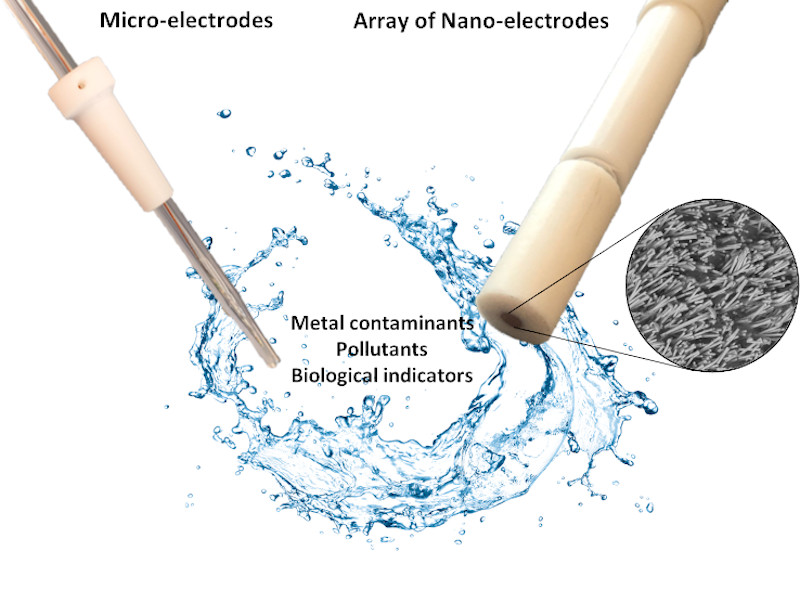
Sensors are developed for the determination of organic pollutants present in tap and wastewater, particularly consisting of phytosanitary products and disinfection by-products. Sensors for these species exploit nanomaterials (metal nanoparticles and graphene) eventually associated with enzymes. Detection of PFAS exploits the use of molecular-printed polymers: biomimetic materials that selectively recognize the analyte for the presence of sites of specific dimension and shape.
Selected references:
Collaborations:

The research group develops electrochemical sensors for the non-invasive analysis of various biomarkers in biological fluids, such as urine, saliva, and sweat. Multi-sensor platforms are developed for the determination of electrolytes and organic molecules in sweat and to define the effects of prolonged exposure to organic pollutants. The detection exploits innovative, environmentally sustainable, low-cost sensor platforms, obtained using polymers, paper, and fabric as substrates.
References:
Collaborations:

Electrode systems characterized by single arrays of micro- and nano-electrodes are developed to conduct “in situ” diagnostic investigations, and in small volume samples, on the electrochemical processes of electroactive species present in real complex matrices. The attention is mainly focused on applications in the environmental, clinical, and food fields for the determination of trace-level concentrations of natural components, metal contaminants, or biological indicators of the studied matrices.
Selected references:
Collaborations:

With the advent of flexible electronics, the old-fashioned and conventional solid-state technology will be replaced by conductive inks combined with low-cost printing techniques. 2D nanomaterials are ideal candidates to produce conductive inks, due to their excellent conductivity. The possibility to chemically modify these materials allows us to obtain inks responsive to external stimuli. Combined with classical printing techniques, such as screen and inkjet printing these inks can be used to produce electroanalytical platforms.
Selected references:
Collaborations:

SECM and SEMC allow the performing of electrochemical investigations on the chemical reactivity of a variety of surfaces and interfaces (inorganic, organic, and biologic systems) at high spatial resolution. These techniques provide images of the chemical and redox properties of the investigated surfaces.
Selected references:
The desire to improve the standards of healthcare, food safety, and environmental monitoring all over the globe is the leading impulse behind the development of transient and disposable sensors. These are sensors designed for short-term or single-use applications, after which they can be easily and safely disposed of with a minimum impact on the environment. In this context, synthetic, natural polymers and 2D materials (2DM) are interesting candidates to achieve environmentally sustainable electronics. Based on covalent organic framework (COF) chemistry, TwoDe-ink aims to synthesize a 2D electrocatalyst tailored as an efficient transducer in amperometric biosensors. The building blocks composing the COF will be carefully designed to cover all the functions required for electrochemical sensing: electro-catalytic activity, conductivity, solution processability, possibility to post-functionalize it with receptors.
TwoDe-Ink is based at Ca' Foscari's Department of Molecular Sciences and Nanosystems, under the supervision of Prof. Alessandro Silvestri.
ProCleanLakes aims to integrate innovative approaches for the protection and restoration of natural lakes, addressing both environmental sustainability and water quality management. By combining advanced monitoring technologies, eco-friendly remediation strategies, and community engagement, the project seeks to develop effective and long-lasting solutions for preserving freshwater ecosystems. Through interdisciplinary collaboration, ProCleanLakes will assess pollution sources, evaluate emerging contaminants, and implement nature-based solutions to mitigate their impact. The project will also foster knowledge exchange among researchers, policymakers, and local stakeholders, ensuring that its findings contribute to the development of sustainable lake management policies.
ProCleanLakes is supported by the European Union and brings together experts from various institutions across Europe to safeguard natural lakes for future generations. At Ca' Foscari University of Venice, the project is hosted under the supervision of Prof. Chiara Zanardi.
Amyotrophic Lateral Sclerosis (ALS) is a neurodegenerative disorder characterized by the combined degeneration of upper and lower motor neurons. Despite intensive research efforts, no validated biomarkers for disease diagnosis and progression exist. The aim of SENSATI-ON-ALS is to develop biosensors for the detection of pyroptosis-related cytokines in skin interstitial fluid (ISF) that is considered an efficient source of inflammatory biomarkers that complements conventional sources, such as blood and urine. SENSATI-ON-ALS will open a new avenue for non-invasive measurement of pyroptosis-related biomarkers that could help clinicians for diagnosis and disease monitoring, and lastly will pave the way for new therapeutic strategies counteracting neurodegeneration by inhibiting inflammasome activation.
SENSATI-ON-ALS is developed by nano4Sens research group in collaboration with Dr, Ines Fasolino (CNR) and Dr. Raffaele Dubbioso (Università degli Studi di Napoli Federico II).
Madder lakes and geranium lakes are two pigments widely used in historic-artistic pieces. Under light exposure and in the presence of oxygen they generate singlet oxygen, one of the reactive oxygen species known for being a strong oxidant that promotes degradation reactions in historical paintings. This EU-funded project aims to provide further understanding regarding the generation of singlet oxygen from historical pigments, the impact of the (micro)environment, and how this can be applied to improve the preservation of historical paintings.
PHOTOELECTROART is based at Ca' Foscari's Department of Molecular Sciences and Nanosystems, under the supervision of Prof. Ligia Moretto and in collaboration with Prof. Karolien De Wael (University of Antwerp, Belgium) and Dr. Ferenc Borondics (Synchrotron Soleil, France).
Giuseppe Misia, Michele Cesco, Maurizio Prato, Alessandro Silvestri (2025). Supramolecular electrostatic functionalization of 1T-MoS 2 based on alkylammonium salts. “Nanoscale”